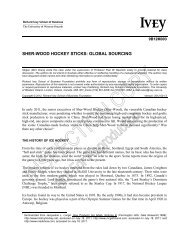foundation of canada asia pacific - Content Tagged with
foundation of canada asia pacific - Content Tagged with
foundation of canada asia pacific - Content Tagged with
Create successful ePaper yourself
Turn your PDF publications into a flip-book with our unique Google optimized e-Paper software.
○ ○ ○ ○<br />
○ ○ ○ ○<br />
○ ○ ○ ○<br />
○ ○ ○ ○<br />
○ ○ ○ ○<br />
○ ○ ○<br />
○ ○<br />
○ ○<br />
○ ○<br />
○ ○<br />
○ ○<br />
○ ○<br />
○ ○<br />
○ ○<br />
○ ○<br />
○ ○<br />
○ ○<br />
○ ○<br />
○ ○<br />
○ ○<br />
NINE-MONTH TRADE COMPARISON (C $BILLIONS)<br />
0 2 4 6 8 10 12 14 16 18 20 22 24 26 28 30 32 34 36 38 40<br />
1998<br />
1999<br />
Canadian Exports to Asia<br />
Canadian Imports from Asia<br />
Sources: Adapted from Statistics Canada, Exports by Country, various issues 1989-1999 (Cat. No. 65-003) and Imports<br />
by Country, various issues 1989-1999 (Cat. No. 65-006).<br />
9<br />
<strong>with</strong> Asia. However, as argued in Chapter 3, Looking for a New Model, in the globalized<br />
economy, a greater return would likely have come from promoting Canadian direct<br />
investment in Asia, rather than devoting so much effort to winning export contracts.<br />
Canada’s active participation in the Asia Pacific Economic Cooperation (APEC) forum is<br />
another area where the government is trying to encourage business by opening doors<br />
into Asia (and parts <strong>of</strong> Latin America) for Canadian trade and investment. However,<br />
despite Ottawa’s best efforts to give greater direction to the organization, the APEC<br />
process is diffuse and quite long-term — the target date for removal <strong>of</strong> all trade barriers<br />
is 2020. Many observers believe the process <strong>of</strong> removing formal barriers to trade and<br />
investment (as opposed to less formal regulatory impediments) has already run out <strong>of</strong> steam.<br />
There is another, more direct, approach that Ottawa could take.<br />
While Canada is almost always committed to seeking multilateral solutions to any<br />
problems it identifies, trade and investment have a national basis, even in the globalized<br />
economy. Negotiation <strong>of</strong> bilateral treaties that enhance security for Canadian investment<br />
is one avenue Ottawa could follow to support the development <strong>of</strong> a stronger economic<br />
relationship <strong>with</strong> Asia. At present, Canada has investment protection treaties in place<br />
<strong>with</strong> only two Asian countries — the Philippines and Thailand — though there are<br />
non-binding memoranda <strong>of</strong> understanding <strong>with</strong> several others. A more promising<br />
approach was Ottawa’s move in 1994 toward developing a closer relationship <strong>with</strong><br />
South Korea. It established a Special Partnership Working Group <strong>with</strong> Seoul to explore<br />
ways for the two countries to increase bilateral economic ties and to work together in<br />
third-country markets. In 1996, this yielded the Canada-Korea Arrangement on Industrial<br />
and Technological Co-operation, to help build Canada’s role in Korea’s growing<br />
services and advanced technology sectors, and last year a treaty on investment in the<br />
telecommunications sector. Because <strong>of</strong> the Asian crisis, however, there has been little<br />
progress in broadening this relationship until recently, when dialogue resumed. There<br />
are some indications that Ottawa is considering developing a similar relationship or<br />
even negotiating a free-trade agreement <strong>with</strong> Japan. Though difficult to envisage, if<br />
achieved it would provide the strongest possible signal to the private sector to look beyond<br />
North America for trade and investment. And it would bring 82% <strong>of</strong> Canada’s global trade<br />
into a free-trade environment.



